First unveiled at the end of Ken Block’s last Gymkhana video, Gymkhana 8, the Ford Focus RS RX first appeared as a shadowy pre-production teaser, all outrageously wide and vent-y, with blacked-out headlights and a skunkworks-style grey finish.
Immediately, it set the internet ablaze: just what was this monstrous looking car? Was it the much-rumoured hardcore version of the Focus RS, as if the production car wasn’t hardcore enough? Or maybe an RS-derived competition car?
As it turns out, it’s a bit of both and now stars in a feature all of its own, the latest Gymkhana 9 video which was released just today and which you can watch below.
Outside of serving as the latest eyeball-searing ride Block has used for his Gymkhana series, the Focus RS RX was built specifically for use in the World Rallycross Championship.
Only two in the word exist, one for Block and one for his Hoonigan Racing teammate Andreas Bakkerud. Both are under strict instruction not to destroy them, but that hasn’t stopped Ken from thrashing his around the streets of Buffalo, New York anyway.
Read below to find out everything you need to know about the Ford Focus RS RX, from how much power it makes to how it was built.
The concept
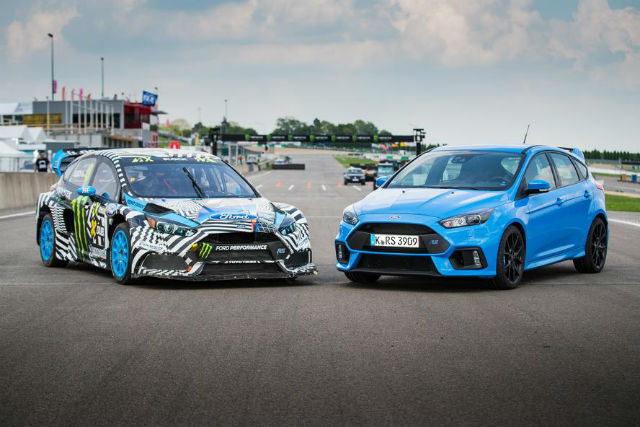
In the past, most RS badged Fords were built to satisfy homologation requirements so that the manufacturer could enter the car into a particular racing or rally series. With the new Ford Focus RS, it’s the other way round: the RS RX is the competition version of the road-going RS, rather than the RS being the road-going version of a competition car.
Developed as part of a partnership between Ford’s Performance wing, Ken Block’s Hoonigan Racing team and M-Sport, Ford’s official partners in the World Rally Championship, the Focus RS RX is a purpose-built racing machine developed for the FIA World Rallycross Championship.
Previously, Ford and Hoonigan have extensively fielded Fiestas both in rallycross events and stage rally, and the RS RX takes many of the lessons learned from the smaller car and adapts them for the all-new format.
The Focus RS RX starts life on the exact same production line as the regular RS, which itself is built on the same line as every other standard Ford Focus in Ford’s Saarlouis plant in Germany. Painted in white, the car is then shipped to M-Sport’s headquarters in Cumbria to begin its transformation from production car to full-bore racer.
Mechanicals and interior
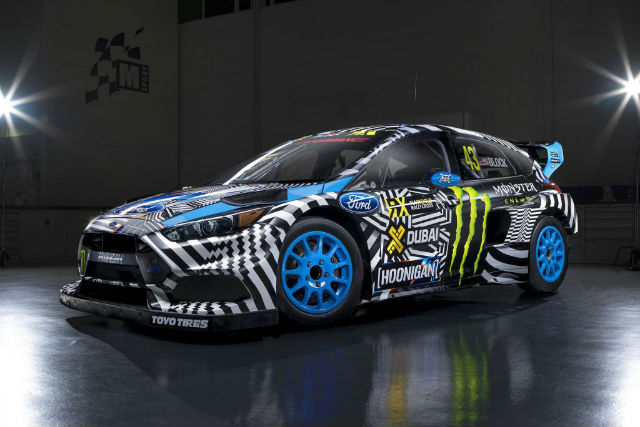
Due to the fact that the RX is so specific to rallycross, it features a number of features and upgrades that the road-going model wouldn’t be able to have. For a start, virtually every non-essential part is stripped out, including the passenger and rear seats and sound deadening material, in order to save weight.
A competition-spec roll cage is then welded into the car, which adds a little of the weight back but crucially makes the car a lot more rigid than it would be otherwise.
The stripped-out interior of the RS RX also allowed Ford and M-Sport to make some radical changes to the driving position too. Compared to the Fiesta, the RS RX is noticeably larger and in order to ensure the car handles well, M-Sport shifted the steering column and the driver’s seat back towards the middle of the chassis.
That means that Block and Bakkerud sit much further back in the vehicle than virtually any other car. Everything from the exact position of the hand controls, the gear shifter and the handbrake was scrutinised and personalised for each car and each driver to ensure it’s as ergonomically perfect for its pilot as possible.
The suspension system is also much different to the road car, with the front strut bars taken out and double wishbone suspension installed in the front and the rear. Ford’s clever torque-vectoring four-wheel drive system is also dumped in favour of a more traditional four-wheel drive system with a standard differential.
Rallycross rules state that competition cars aren’t allowed any sort of active systems like torque vectoring, or anything else that would give drivers the edge over each other in a race, but the standard system also wouldn’t be able to handle the sheer power the RS RX generates.
Drivetrain and power
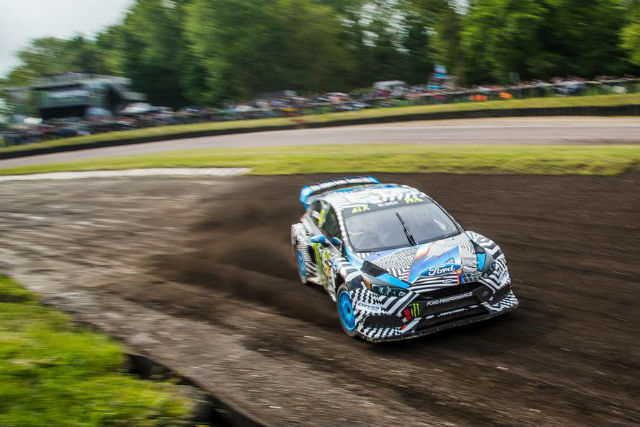
That power comes courtesy of a bespoke engine built by Ford in conjunction with M-Sport. Although the standard RS uses a 2.3-litre EcoBoost engine, the RS RX’s engine is only 2.0-litres, but can generate north of 600bhp: nearly twice the power of the standard Focus RS.
Compared against other racing series like Formula One, the rules for manufacturers in rallycross are reasonably lax, meaning that teams are free to manufacture their own custom engines if they so wish.
However, due to the sheer amount of power generated, rallycross engines tend to have a relatively short lifespan, and so the RS RX’s motor is based on a production Ford engine to make turnaround easier, albeit one that's been highly tuned and modified.
That extra power also means that extra consideration must be given to cooling systems, which in part explains the radical appearance of the RS RX. Compared against the road car, it’s had its radiator moved to the boot area, with large twin pipes funnelling air from the car’s front scoops, through the body and directly into the radiator.
Switching the radiator to the back also means that the Focus RS RX can afford to have a larger intercooler at the front. A larger intercooler means the car can handle more boost pressure from its turbocharger, which in turn means even more power.
It’s not clear exactly how much power the RS RX makes, as its output is often hampered by turbocharger restrictors to limit the amount of air that feeds the engine, but the supercar class in which it competes in rallycross features cars with outputs of 600bhp or more.
The RS RX therefore produces at least 600bhp and has a torque output of around 900Nm, meaning that it can hit 62mph from a standing start in just 1.9 seconds – much faster than even the world’s fastest production car.
Downforce isn’t ignored exactly and the RS RX features a large rear wing similar to those that feature on WRC cars, but as with stage rally it’s a less important consideration for a car that spends a lot of its time going sideways.
What else do I need to know?
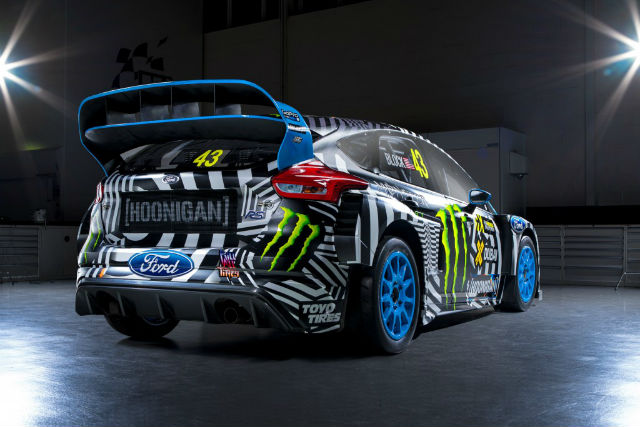
Speaking of sideways, Block is probably best known for his drift-king status thanks to the Gymkhana videos, and like his other cars it’s likely that the RS RX can be modified to accommodate the kind of on-road gymnastics that made its driver a household name amongst car fans.
To achieve his monster stunts, Block has his rallycross cars set up with a bespoke suspension setting, slippy tyres and a larger turbo restrictor so that the car can perform on solid tarmac the way a rally car would on loose gravel.
Perhaps the most incredible thing about the Focus RS RX is how quickly it was developed, and how quickly it’s been a success too. It can often take racing teams years to perfect their cars, but the RS RX was developed and built in just nine months, won the first heat it was entered in and has achieved a podium position in five of the past seven races it’s ran.
After development of the car was finished, the end result was sent to Block and Bakkerud for extensive shakedown testing before being unleashed on the rallycross circuits, and now on the public roads. The final touch came from artist Felipe Pantone, who designed the eye-catching wraps unique to both cars.
Will I ever be able to buy one?
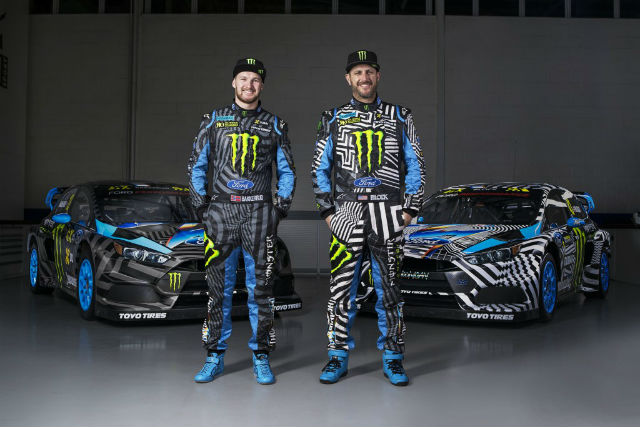
Currently, it’s unlikely. As we stated before, only two RS RXs currently are in existence and to the best of anybody’s knowledge, there’s probably not any plans to build more unless one of them suffers critical damage.
Despite the best wishes of fans the world over, it’s unlikely we’ll see an RS RX in the WRC either, as Ford’s official partners M-Sport are due to field an updated Fiesta for the new 2017 season.
All the same, depending on the success of the RS RX it’s possible that M-Sport could start producing more. Customers are able to buy M-Sport’s cars, but given that a WRC-spec Fiesta costs upwards of £400,000, for the vast majority of buyers you’ll probably be better off sticking with the standard Focus RS.



